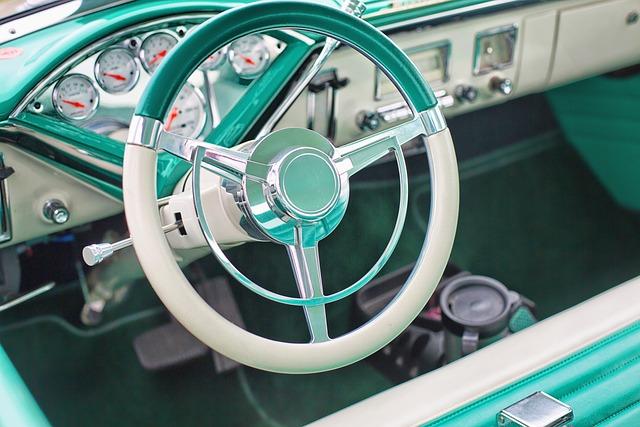Are you tired of staring at that pesky tire pressure light on your Honda CRV’s dashboard? Don’t fret, because we’ve got you covered! In this article, we’ll walk you through the simple steps to resetting the tire pressure light on your Honda CRV so you can hit the road with confidence. Stay tuned to master your CRV’s tire pressure light like a pro!
1. Understanding the Importance of Proper Tire Pressure
Proper tire pressure is crucial for the safety and performance of your vehicle. Here are some reasons why maintaining the correct tire pressure is important:
- Safety: Under-inflated tires can lead to blowouts or accidents, while over-inflated tires can reduce traction and control on the road.
- Fuel Efficiency: Incorrect tire pressure can impact fuel efficiency, costing you more money at the pump in the long run.
- Tire Wear: Improper tire pressure can cause uneven wear, reducing the lifespan of your tires and potentially leading to the need for premature replacements.
By regularly checking and maintaining proper tire pressure, you can ensure a safer and more efficient driving experience. Be sure to reference your vehicle’s owner’s manual for the recommended tire pressure and check your tire pressure at least once a month to stay on top of this important maintenance task.
2. The Dashboard Warning: Tire Pressure Light
When the tire pressure light appears on your dashboard, it is important not to ignore it. This warning light indicates that one or more of your tires have low air pressure, which can lead to decreased fuel efficiency, poor handling, and increased risk of a blowout. By addressing this issue promptly, you can ensure the safety and performance of your vehicle.
Here are some steps you can take to address the tire pressure warning light:
- Check tire pressure: Use a tire pressure gauge to check the pressure in each tire, including the spare. Refer to your vehicle’s owner’s manual for the recommended pressure levels.
- Inflate tires: If any of the tires are low on air, use an air compressor to inflate them to the appropriate pressure level.
- Monitor tire pressure: Regularly check your tire pressure and address any issues promptly to maintain optimal performance and safety.
3. Step-by-Step Guide: Resetting Your Honda CRV’s Tire Pressure Light
Resetting your Honda CRV’s tire pressure light is a simple process that can easily be done at home. Follow these step-by-step instructions to ensure your vehicle’s safety and performance.
Here’s how to reset your Honda CRV’s tire pressure light:
- Check Tire Pressure: Before resetting the light, make sure to check the tire pressure on all four tires. This will ensure that your tires are properly inflated.
- Locate Reset Button: Look for the reset button inside the glove compartment. Press and hold the reset button until the tire pressure light blinks three times.
- Drive the Car: Drive your Honda CRV for a few miles to allow the system to recalibrate. The tire pressure light should turn off once the system has reset.
4. Tips for Maintaining Optimal Tire Pressure
Proper tire pressure is crucial for your vehicle’s performance, safety, and fuel efficiency. Follow these tips to maintain optimal tire pressure:
- Check tire pressure regularly using a tire gauge
- Inflate tires to the recommended pressure listed in the owner’s manual
- Check tire pressure when tires are cold for accurate readings
Underinflated tires can lead to poor handling, decreased fuel efficiency, and premature tire wear. On the other hand, overinflated tires can reduce traction, cause uneven wear, and impact braking distance. By keeping your tires properly inflated, you can improve your driving experience and save money on fuel costs in the long run. Remember, maintaining optimal tire pressure is a simple yet effective way to ensure your safety on the road.
5. Benefits of Regularly Checking and Resetting Your Tire Pressure Light
Regularly checking and resetting your tire pressure light is crucial for maintaining optimal safety and performance in your vehicle. By staying on top of your tire pressure, you can enjoy a variety of benefits that will ultimately save you time and money in the long run.
- Improved fuel efficiency: Properly inflated tires can improve your vehicle’s fuel efficiency by up to 3%, saving you money on gas in the long term.
- Enhanced handling and traction: Maintaining the correct tire pressure ensures better handling and traction on the road, reducing the risk of accidents and improving overall driving experience.
- Extended tire lifespan: Regularly checking and resetting your tire pressure light can help prevent premature wear and tear on your tires, extending their lifespan and ultimately saving you money on replacements.
6. Common Misconceptions About Tire Pressure Light Resetting
Many drivers believe that once their tire pressure light comes on, it simply means they need to add air to their tires. However, this is not always the case. In some vehicles, the tire pressure light may come on not only for low tire pressure, but also for issues with the tire pressure monitoring system itself. It’s important to reset the light after addressing any tire pressure issues to ensure that it doesn’t become a recurring problem.
Another common misconception is that resetting the tire pressure light is difficult or requires a trip to the dealership. In reality, many vehicles have a simple process for resetting the light that can be done by the driver. This typically involves locating the reset button or menu on the dashboard controls, following the instructions in the owner’s manual, and holding the button for a few seconds until the light resets. By taking the time to reset the tire pressure light properly, you can ensure that your vehicle’s tire pressure monitoring system is functioning correctly and avoid any unnecessary trips to the mechanic.
7. How to Properly Inflate Your Honda CRV’s Tires
Proper tire inflation is crucial for maintaining optimal performance and safety in your Honda CRV. Follow these steps to ensure your tires are inflated correctly:
- Check the recommended tire pressure for your Honda CRV in the owner’s manual or on the driver’s side door jamb.
- Use a reliable tire pressure gauge to measure the current pressure in each tire.
- If the pressure is too low, use an air compressor to inflate the tires to the recommended level.
- Make sure to check the tire pressure when the tires are cold for the most accurate reading.
Properly inflating your Honda CRV’s tires can improve fuel efficiency, extend tire life, and enhance overall driving performance. Remember to check your tire pressure regularly to ensure a smooth and safe driving experience.
8. Master Your Honda CRV: Take Control of Your Tire Pressure Light
When the tire pressure light in your Honda CRV comes on, it’s important to address it promptly to ensure your safety and maintain optimal performance. Here’s how you can take control of your tire pressure light:
First, make sure to check your tire pressure regularly, at least once a month, using a reliable tire pressure gauge. Proper tire pressure not only helps improve fuel efficiency, but also ensures better traction, handling, and overall performance. If the tire pressure light comes on, don’t ignore it – take the necessary steps to inflate or deflate your tires to the recommended levels. Additionally, inspect your tires for any punctures, damage, or wear and tear that may affect tire pressure. Regular maintenance and monitoring of tire pressure will help keep your Honda CRV running smoothly and safely on the road.
Frequently Asked Questions
Q: Why is it important to reset the tire pressure light on a Honda CRV?
A: Resetting the tire pressure light is crucial for maintaining optimal tire performance and safety while driving.
Q: How can I reset the tire pressure light on my Honda CRV?
A: It’s easy to reset the tire pressure light on your Honda CRV by following a few simple steps outlined in our article.
Q: Can neglecting to reset the tire pressure light cause damage to my vehicle?
A: Yes, neglecting to reset the tire pressure light can lead to uneven tire wear, decreased fuel efficiency, and even potential safety hazards on the road.
Q: Are there any tools or equipment needed to reset the tire pressure light on a Honda CRV?
A: No special tools are required to reset the tire pressure light on a Honda CRV, making it a quick and easy process for all drivers.
Q: How often should I check my tire pressure on my Honda CRV?
A: It’s recommended to check your tire pressure regularly, at least once a month, to ensure optimal performance and safety while driving.
Q: Can I reset the tire pressure light on my Honda CRV myself, or should I take it to a professional?
A: You can easily reset the tire pressure light on your Honda CRV yourself following the steps outlined in our article. However, if you are unsure or uncomfortable, it’s always best to consult a professional for assistance.
Key Takeaways
In conclusion, mastering the art of resetting the tire pressure light on your Honda CRV is a simple and essential task that every car owner should know how to do. By following the easy steps outlined in this guide, you can ensure that your vehicle is operating at peak performance and safety levels at all times. Remember, regular maintenance and attention to detail are key to keeping your CRV running smoothly for years to come. So don’t wait any longer, take control of your vehicle’s tire pressure and reset that light today! Drive safe, and happy motoring!




